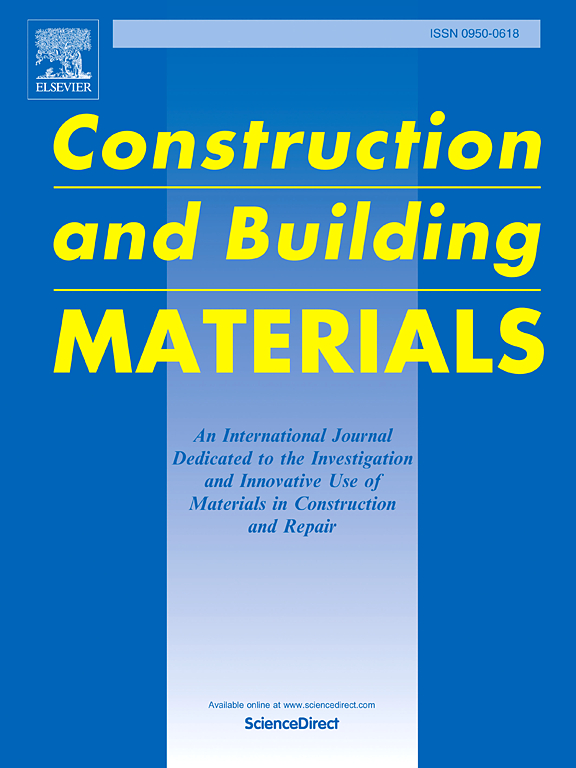Comprehensive analysis of pre-crack parameters on repeated impact strength and failure mechanism: Effects of crack depth, length, and position in engineering cementitious composites
IF 7.4
1区 工程技术
Q1 CONSTRUCTION & BUILDING TECHNOLOGY
引用次数: 0
Abstract
Assessing the impact resistance of engineering cementitious composites (ECC) is essential for applications that demand exceptional durability under impact loading conditions. The impact testing method developed by the American Concrete Institute (ACI) Committee 544 has traditionally been employed to evaluate the concrete impact resistance. However, current research predominantly focuses on uncracked specimens, with limited attention given to the effect of pre-existing cracks on the repeated impact strength and failure mechanisms. This study attempts to examine the impact of pre-crack depth, length, and location on the impact behavior of ECC specimens, utilizing ACI impact test specimens with intentionally introduced pre-cracks. This study presents an innovative approach by investigating 17 distinct pre-cracked specimen configurations, with cracks positioned at the bottom and impact loads applied to the top, where no predefined cracks are present. This unique specimen arrangement represents a significant contribution to the current research. The polypropylene fiber was used to prepare the ECC at 2 % dosage. Additionally, the impact strength was presented in terms of reliability by analysing the data dispersion using the Weibull distribution. Results indicate that increasing crack depth significantly reduces the impact strength of ECC specimens. Specifically, for a central full-length pre-crack, initial cracking and failure impact numbers decrease by up to 89.81 % and 78.00 %, respectively, as crack depth increases from 15 mm to 45 mm. This demonstrates an inverse relationship between crack depth and tensile performance, with deeper cracks impairing load distribution efficiency. Pre-crack location significantly influences impact resistance. Eccentric cracks (e.g., 50 mm from the centerline) result in smaller reductions in impact strength compared to centrally located cracks.
预裂参数对工程胶凝复合材料重复冲击强度及破坏机理的综合分析:裂缝深度、长度和位置的影响
评估工程胶凝复合材料(ECC)的抗冲击性对于在冲击载荷条件下需要特殊耐久性的应用至关重要。冲击试验方法是美国混凝土学会(ACI) 544委员会制定的冲击试验方法,传统上用于评价混凝土的抗冲击性。然而,目前的研究主要集中在未开裂的试件上,对已有裂纹对重复冲击强度的影响和破坏机制的研究较少。本研究试图研究预裂纹深度、长度和位置对ECC试件冲击行为的影响,利用有意引入预裂纹的ACI冲击试件。本研究提出了一种创新的方法,通过研究17种不同的预裂试样配置,裂缝位于底部,冲击载荷施加于顶部,其中没有预定义的裂缝存在。这种独特的标本排列对当前的研究有重大贡献。以聚丙烯纤维为原料,以2 %的用量制备ECC。此外,通过使用威布尔分布分析数据离散度,从可靠性的角度提出了冲击强度。结果表明,裂纹深度的增加显著降低了ECC试件的冲击强度。具体而言,对于中心全长预裂纹,随着裂纹深度从15 mm增加到45 mm,初始裂纹和破坏冲击次数分别减少89.81 %和78.00 %。这表明裂纹深度与拉伸性能成反比关系,更深的裂纹会影响载荷分配效率。预裂位置对抗冲击性能有显著影响。偏心裂纹(例如,距中心线50 mm)与位于中心的裂纹相比,其冲击强度的降低幅度较小。
本文章由计算机程序翻译,如有差异,请以英文原文为准。
求助全文
约1分钟内获得全文
求助全文
来源期刊

Construction and Building Materials
工程技术-材料科学:综合
CiteScore
13.80
自引率
21.60%
发文量
3632
审稿时长
82 days
期刊介绍:
Construction and Building Materials offers an international platform for sharing innovative and original research and development in the realm of construction and building materials, along with their practical applications in new projects and repair practices. The journal publishes a diverse array of pioneering research and application papers, detailing laboratory investigations and, to a limited extent, numerical analyses or reports on full-scale projects. Multi-part papers are discouraged.
Additionally, Construction and Building Materials features comprehensive case studies and insightful review articles that contribute to new insights in the field. Our focus is on papers related to construction materials, excluding those on structural engineering, geotechnics, and unbound highway layers. Covered materials and technologies encompass cement, concrete reinforcement, bricks and mortars, additives, corrosion technology, ceramics, timber, steel, polymers, glass fibers, recycled materials, bamboo, rammed earth, non-conventional building materials, bituminous materials, and applications in railway materials.
 求助内容:
求助内容: 应助结果提醒方式:
应助结果提醒方式:


